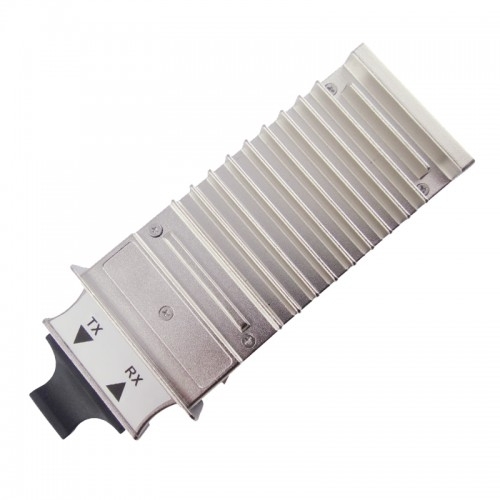- Related articles
- The development background of PCI Express
- 10 Gigabit Ethernet Standards for Optical Fiber Networking
- Optical Transceivers for Cisco SG300-52P-K9-UK Switch
- Used in 40GBASE-ER4 Standard Optical Transceiver Models
- All Cisco SFP-10G-ER-S's information (List price, Specs, Datasheet PDF, Compatibility matr
- All Cisco GLC-TE's information (List price, Specs, Datasheet PDF, Compatibility matrix)
- All Cisco ONS-SI-155-L2's information (List price, Specs, Datasheet PDF, Compatibility mat
- What is DWDM in Telecom?
- The difference between integrated network card and external network card
- All Cisco MFEFX1's information (List price, Specs, Datasheet PDF, Compatibility matrix)

The 40-Gigabit QSFP+ transceiver module can be a hot-swappable, parallel fiber-optical module with four independent optical transmit and receive channels. These channels can terminate in another 40G QSFP+ transceiver , or the channels could be broken out to four separate 10-Gigabit SFP+ transceivers. The QSFP+ transceiver module connects the electrical circuitry of the machine with the copper or an optical external network.
10GBASE X2 modules offer customers a wide variety of 10 Gigabit Ethernet connectivity options for data center, enterprise wiring closet, and provider transport applications.
Definition
The X2 Module supports link lengths of 220m on standard Fiber Distributed Data Interface (FDDI) grade multimode fiber (MMF). To ensure that specifications are met over FDDI-grade, OM1 and OM2 fibers, the transmitter should be coupled through a mode conditioning patch cord.
The QSFP+ switches have pervasive bandwidth requirements due to the tremendous growth in wireless devices are the catalyst for large-scale (100 Gbps) system designs in server farms. QSFP+ connectors transmit up to 25 Gbps per-serial-lane data rates with excellent signal integrity, relieving some of the pressure on core switches.
Difference between X2 and QSFP+
QSFP+
- QSFP+ MSA, SFF-8436 compatible
- Four independently addressable transmit and receive channels
- Highly compact: savings of 60% on edge and board usage compared to four comparable SFP+ modules
- Electrically hot-pluggable
- XFP-like latch mechanism for ease-of-insertion
- Digital Diagnostics Monitoring Interface. allows customer management and monitoring of key modules parameters, analogous to SFP+
- Optical connectivity via industry standard MPO/MTP terminated fiber ribbon
X2 10G
It is the successor of the XENPAK. Brought to the table a reduced size but still using SC connectors.
- Compatible with SENPAK MSA Rev 3.0
- Support of IEEE 802.3ae 10GBASE-L
- XENPAK MSA package with duplex LC connector
- With Digital Diagnostic Monitor Interface
- Operating temperature range 0 to 70 degrees Celsius
- Hot Pluggable 70-PIN Connector with XAUI Electrical Interface
Applications
QSFP+ to QSFP+ Cables Active Optical Cables is made for data transmission over copper cables. These cables contain four data lanes in each direction with a total bandwidth of 40Gbps. These types of cables are widely used in data- and telecom centers for short range multi-lane data communication and operate on a wavelength of 850nm. The QSFP+ to QSFP+ High-Speed Active Optical cables are designed for use between two devices with QSFP+ ports. The Cables can operate on 4 different channels 10/5/2,5Gbps and can reach in total 40Gbps. The length of the cable can vary from 1 meter up to 100 meters. The X2 offer customers a wide variety of 10 Gigabit Ethernet connectivity options for data center, enterprise wiring closet, and service provider transport applications.
CVR X2 SFP
It acts as a protection for 10 Gigabit Ethernet switches (such as the Cisco Catalyst 4500, 3750, and 3560 E-Series Switches), by enabling migration from Gigabit Ethernet to 10 Gigabit Ethernet uplinks based upon business needs, without having to upgrade the switches or modules.
Difference between XFP and SFP+
Both of them are 10G fiber optical modules and can connect with another type of 10G modules. The size of SFP+ is smaller than XFP, thus it moves some functions to the motherboard, including signal modulation function, MAC, CDR, and EDC.XFP is based on the standard of XFP MSA.
Conclusion
Optical transceiver market is growing rapidly and expected to be worth billion dollars. Network designers confirm that big data technology in the data center is a major contributor to this growth. A transceiver, as a necessary component in the data center, can help executives to get their data in real-time, thus people can make immediate decisions. This is why it’s so important to be aware of how transceivers help to support big data.
Expand knowledge:
The differences between X2, sfp, gbic, etc transceivers are typically just physical. Which type to select relates to what has been designed in by the manufacturer to be used in the equipment platform you have selected for your network (See link to Compatibility Guide below). Generally speaking, each transceiver style will support the various specifications for link length and fiber type.
Compatibility Guides
http://www.cisco.com/en/US/products/hw/modules/ps5455/products_device_support_tables_list.html
More Cisco Transceiver Info
https://supportforums.cisco.com/docs/DOC-13721
Singlemode fiber has a smaller optical core, enabling longer link lengths using expensive lasers. Multimode fiber has a larger core, designed for shorter link lengths, but uses lower cost LEDs and Lasers. The link below is a great resource for getting an understandable overview of fiber optics.
Fiber Optics - Basics
http://fiberu.org/basic/index.html






















































